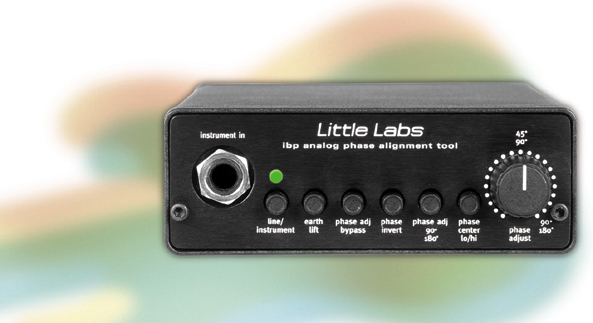Description
Real time all analog phase sweep between zero and one hundred and eighty degrees… and everything in-between .
Allows mics to be placed where they sound best individually, compromising mic placement due to phase problems is not necessary when using the ibp.
+4dB XLR balanced input and outputs.
Internal super quality active transformer isolated line level direct box.
Re-amp capability for bringing +4dB line level signal to guitar level.
Buffered instrument level output for driving long guitar cable.
Allows splitting between two instrument amps with transformer isolation and phase sweep.
Rack mountable 4 IBPs fit in a1U 19″ standard rack space.
Extremely high quality construction. Made in the U.S.A.
Introducing the IBP (in-between phase) analog phase-alignment tool, Little Labs tackles previously unaddressed problems faced daily in recording sessions.
The IBP was designed to help engineers effectively eliminate the undesirable hollow sound when combining out-of-phase and partially out-of-phase audio signals. The IBP will allow engineers to put an audio signal in phase, when the mixing desk’s polarity button will not. Whether combining direct and miked signals, drum kit tom-tom mics, multiple split-guitar amps, top and bottom snare, or the classic acoustic guitar and vocal mic phase problem, audio signals will be put in phase quickly and easily with the Little Labs IBP analog phase-alignment tool.
The Little Labs IBP combines real-time, line-level phase control with audiophile quality. Additionally, its selectable instrument input stage utilizes the super-fidelity circuitry of the well respected Little Labs Multi Z DI and PCP Instrument Distro.
Simply used as a direct box, the IBP allows a bass player to walk into a session, feed the console desk line level and send a buffered guitar signal out to a combo amp. When levels are brought up to the desk, the bass player himself can tweak the IBP phase-adjust putting the miked and direct tracks in phase. Producing a solid in-phase bass sound with the IBP will make the engineer and bass player both look and sound great.
And if that is not enough the IBP can re-amp, bringing your +4dB line level signal to guitar level, with or without phase adjustment. Furthermore the IBP using the instrument in, buffered out, and re-amp out simultaneously, will work as a guitar splitter with one output phase adjusted for creative summing and cancelling between guitar amps.
IBP functional Description: From left to right:
line/instrument selects between the line level xlr input on the rear (unity gain) and when pushed in the instrument in on the front (hi Z 10M with gain) for using as a direct box.
Earth lift lifts the ground (pin 1)of the output xlr.
Phase adjust bypass does just that, bypassing all phase adjust circuitry and allows you to use the IBP without phase adjust, as an active DI or when using the line input, a transformer isolated line driver.
Phase invert is a simple polarity reversal as you would find on a mixing console out is 0 degrees, in is 180 degrees.
Phase adjust 90 degrees /180 degrees selects between two stages (button out) or one stage of phase adjust. This allows a more extreme phase adjustment with a full swing of as much as 180 degrees or a less extreme 90 degrees of phase adjustment.
Phase center lo/hi selects between a higher bandwidth phase adjust (button out)and a primarily lower frequency phase adjust (button in). This and the phase adjust button create the phase curve. It is important to note phase is frequency dependent and is different than time. For example depending on the two sources you are combining, and whether one source is direct and one is miked- between room reflections distance from the cabinet etc. determines what the curve would need to be. (e.g. you need to get the G note in phase as well the A note).
Phase adjust knob determines the degree of phase adjust.
On the rear of the unit you have a re-amp instrument level out. This will, when line level is selected bring the +4dB balanced signal down to instrument level. This output is affected by the phase adjust when selected. When instrument is selected the re-amp out is an instrument level output that is affected by the phase adjust(and can be used in a stomp box type mode). The level trim for the re-amp can be reached with a standard trim tool.
On the rear of the unit you also have a buffered instrument out which follows the instrument input and is designed for running long guitar cables. This output is unaffected by the phase adjust.
The xlr balanced input is designed for balanced line level sources, the xlr output is transformer isolated and can feed balanced or unbalanced line level inputs.
The gain trim for the Di can be reached with a standard trim tool and can be set from 12 to26 db of gain.
Additional information
| Weight | 2 kg |
|---|
